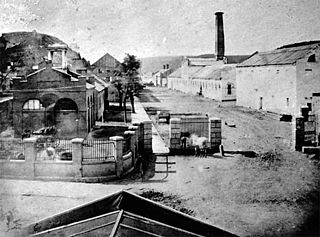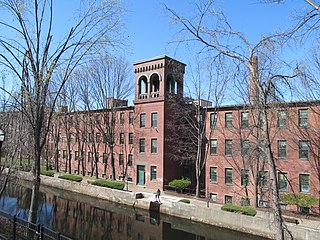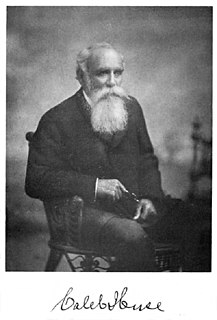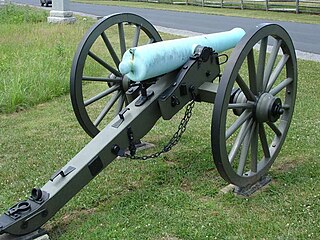
The Springfield Armory, more formally known as the United States Armory and Arsenal at Springfield located in the city of Springfield, Massachusetts, was the primary center for the manufacture of United States military firearms from 1777 until its closing in 1968. It was the first federal armory and one of the first factories in the United States dedicated to the manufacture of weapons. The site is preserved as the Springfield Armory National Historic Site, Western Massachusetts' only unit of the national park system. It features the world's largest collection of historic American firearms.

The St. Louis Arsenal is a large complex of federal military weapons and ammunition storage buildings operated by the United States Air Force in St. Louis, Missouri. During the American Civil War, the St. Louis arsenal's contents were transferred to Illinois by Union Captain Nathaniel Lyon, an act that helped fuel tension between secessionists and those citizens loyal to the Federal government.

Field artillery in the American Civil War refers to the artillery weapons, equipment, and practices used by the Artillery branch to support the infantry and cavalry forces in the field. It does not include siege artillery, use of artillery in fixed fortifications, or coastal or naval artillery. Nor does it include smaller, specialized artillery classified as small arms.

The Model 1832 foot artillery sword was a 25-inch (64 cm) short-sword with a straight, double-edged blade and brass-mounted leather scabbard.
The Springfield Model 1812 Musket is a .69 caliber, flintlock musket manufactured by the Springfield Armory.

The Commonwealth of Massachusetts played a significant role in national events prior to and during the American Civil War (1861-1865). Massachusetts dominated the early antislavery movement during the 1830s, motivating activists across the nation. This, in turn, increased sectionalism in the North and South, one of the factors that led to the war. Politicians from Massachusetts, echoing the views of social activists, further increased national tensions. The state was dominated by the Republican Party and was also home to many Radical Republican leaders who promoted harsh treatment of slave owners and, later, the former civilian leaders of the Confederate States of America and the military officers in the Confederate States Army.

During the American Civil War, Arkansas was a Confederate state, though it had initially voted to remain in the Union. Following the capture of Fort Sumter in April 1861, Abraham Lincoln called for troops from every Union state to put down the rebellion, and Arkansas and several other states seceded. For the rest of the civil war, Arkansas played a major role in controlling the Mississippi River, a major waterway.

The Harpers Ferry Armory, more formally known as the United States Armory and Arsenal at Harpers Ferry, was the second federal armory created by the United States government. It was located in Harpers Ferry, Virginia. It was both an arsenal, manufacturing firearms, and an armory, a storehouse for firearms. Along with the Springfield Armory, it was instrumental in the development of machining techniques to make interchangeable parts of precisely the same dimensions.
The Whitworth rifle was an English-made percussion rifle used in the latter half of the 19th century. A single-shot muzzleloader with excellent long-range accuracy for its era, especially when used with a telescopic sight, the Whitworth rifle was widely regarded as the world's first sniper rifle.

The Richmond rifle was a rifled musket produced by the Richmond Armory in Richmond, Virginia, for use by the Confederate States Army during the American Civil War.

William Henry Talbot Walker was an American soldier. He was a career United States Army officer who fought with distinction during the Mexican-American War, and also served as a Confederate general during the American Civil War. Walker was severely wounded many times in combat, and was killed in action during the 1864 Atlanta Campaign.

Ames Manufacturing Company was a manufacturer of swords, tools and cutlery in Chicopee, Massachusetts, as well as an iron and bronze foundry. They were a major provider of side arms, swords, light artillery, and heavy ordnance for the Union in the American Civil War. They also cast a number of bronze statues which can be found throughout New England.

Caleb Huse was a major in the Confederate States Army, acting primarily as an arms procurement agent and purchasing specialist during the American Civil War. He is most well known for his successful acquisition of weapons contracts with various European nations including the United Kingdom, Austria, and to a lesser extent, France, Prussia, and Bohemia. A majority of the weapons imported to the Confederacy from foreign powers during the war were negotiated for and purchased by Huse.
The Shoup's Mountain Battery (1862–1865) was a Confederate Army artillery battery during the American Civil War. It was also known as Shoup's Battery. At least two of the battery officers later served in the 8th Arkansas Field Battery.
The Louisiana Legion was a militia unit based in New Orleans, Louisiana. Formed in 1821, it was "the oldest brigade in the city." It was a combined arms force, with infantry, cavalry and artillery components. The Louisiana Legion was disbanded, along with all other volunteer Louisiana companies, in February 1862 to free soldiers to join other American Civil War units.
The Confederate Armory Site, a.k.a. Jones, McElwain and Company Iron Foundry, is a historic site in Holly Springs, Mississippi, USA. It contains the scant ruins of the foundry built there in 1859, converted to an armory in 1861 by the Confederate States Army, used as a hospital by the Union Army in November 1862, and razed by the Confederates a month later.

The M1857 12-pounder Napoleon or Light 12-pounder gun or 12-pounder gun-howitzer was a bronze smoothbore muzzle-loading artillery piece that was adopted by the United States Army in 1857 and extensively employed in the American Civil War. The gun was the American-manufactured version of the French canon obusier de 12 which combined the functions of both field gun and howitzer. The weapon proved to be simple to produce, reliable, and robust. It fired a 12.3 lb (5.6 kg) round shot shell a distance of 1,619 to 1,680 yd at 5° elevation. It could also fire canister shot, common shell, and spherical case shot. The 12-pounder Napoleon outclassed and soon replaced the M1841 6-pounder field gun and the M1841 12-pounder howitzer in the US Army, while replacement of these older weapons was slower in the Confederate States Army. A total of 1,157 were produced for the US Army, all but a few in the period 1861–1863. The Confederate States of America utilized captured US 12-pounder Napoleons and also manufactured about 500 during the war. The weapon was named after Napoleon III of France who helped develop the weapon.











